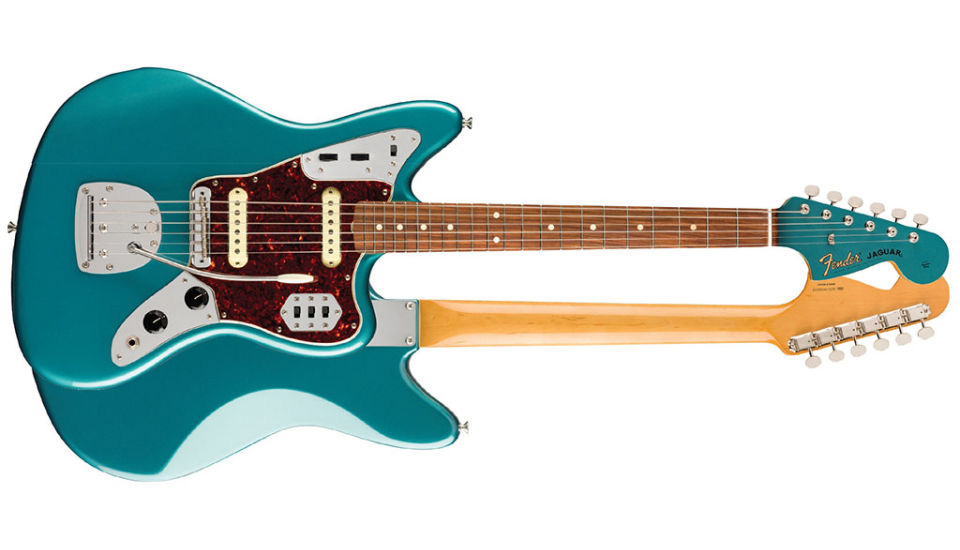GuitarPlayer Verdict
This tight and tidy reinterpretation of Fender's black sheep model has snappy, well-rounded tone that's perfect for a wide variety of genres
Pros
- +
A vintage-leaning interpretation of the classic Jaguar, capturing chic looks and alternative tones at a reasonable price
Cons
- -
Sharp fret ends on our review sample
You can trust Guitar Player.
Released in 1962 as Fender’s top-of-the-line and most expensive model, the Jaguar was overly complex for some players and became something of a black sheep. Over the ensuing decades, however, its relative affordability on the used market made it a favorite with indie, punk and alt-rockers.
Today, whether or not they play one, most guitarists acknowledge there’s something undefinably cool about this short-scale offset model, and the Vintera ’60s Jaguar oozes it. Outwardly, the Vintera model appears to be period correct through and through.
It features the unbound neck with dot inlays and tortoiseshell pickguard, and is offered in a choice of Three-Color Sunburst or Ocean Turquoise finishes. Our review model came in the latter. The body is solid alder, cut to the classic offset Jaguar lines, while the fingerboard is pau ferro, a popular modern alternative with a grain similar to rosewood, if often a lighter-brown shade.
That aside, this model actually leans more vintage than modern era. It retains the original Jag’s 24-inch scale length, which is part and parcel of the guitar’s character, delivering that round, yet snappy tone to which a shorter scale contributes.
The fretboard radius is a curvaceous 7.25 inches, the frets are vintage-narrow, the neck shape is described as a mid-’60s C profile, the truss-rod adjustment is at the neck heel and the tail-end hardware includes the six-saddle “rocker” bridge with threaded saddles and a vintage-style floating JM/Jag vibrato tailpiece.
Controls include the original master volume, tone and three-switch complement, plus the less-used rhythm circuit. Pickups are traditional single-coil Jaguar units, which have the unique “claw” frames that repel electrostatic interference and beef up this otherwise bright pickup’s response, too.
Construction is tight and tidy, and whatever they want to call this mid-’60s-inspired neck profile, it’s a universally appealing shape, with a rounded, medium-depth carve that has fullness without being club-like.
Like our Strat, this Jaguar had very snaggy fret ends, as it had traveled from Mexico to the cold northeast for review, though they shouldn’t have protruded quite this much. Even so, the guitar plays extremely well. Tuning stability suffers a little with significant vibrato use, but no more so than the average Jag I’ve experienced.
Tested through the same rigs as the Stratocaster, this guitar sounds like a good Jaguar and reminds me why this model has grabbed so much attention. With either amp set to the edge of breakup, the Vintera ’60s Jaguar delivers that enticing blend of trebly, yet meaty tone that applies so well to a surprisingly wide range of genres.
It exudes thick twang for surfy riffs or indie-rock jangle, with that ghost of added shimmer from the strings between vibrato and bridge adding funky overtones. Crank the amp, though, and there’s a nasty snarl that digs in great for garage-rock or punk.
As ever, the rhythm circuit is a little less appealing than the standard-mode switching, but it’s there for quick dark-to-bright transitions when needed. Otherwise, there’s both bite and clarity from all pickup positions, with just enough muscle to avoid ice-pick-like highs.
Specifications
CONTACT fender.com
PRICE $999 street
NUT 1.650", synthetic bone
NECK Maple, Mid-’60s “C” profile
FRETBOARD Pau Ferro, 24" scale, 7.25" radius
FRETS 22 vintage-style
TUNERS Vintage-style
BODY Solid alder
BRIDGE 6-saddle vintage-style adjustable bridge, “floating” tremolo tailpiece
PICKUPS Two vintage-style single-coil Jaguar pickups
CONTROLS Master volume and tone controls, pickup on-off switches, tone-selector switch, rhythm circuit switch with rhythm volume and tone controls
FACTORY STRINGS Fender .009–.042
WEIGHT 8 lbs
BUILT Mexico
Dave Hunter is a writer and consulting editor for Guitar Player magazine. His prolific output as author includes Fender 75 Years, The Guitar Amp Handbook, The British Amp Invasion, Ultimate Star Guitars, Guitar Effects Pedals, The Guitar Pickup Handbook, The Fender Telecaster and several other titles. Hunter is a former editor of The Guitar Magazine (UK), and a contributor to Vintage Guitar, Premier Guitar, The Connoisseur and other publications. A contributing essayist to the United States Library of Congress National Recording Preservation Board’s Permanent Archive, he lives in Kittery, ME, with his wife and their two children and fronts the bands A Different Engine and The Stereo Field.
"We tried every guitar for weeks, and nothing would fit. And then, one day, we pulled this out." Mike Campbell on his "Red Dog" Telecaster, the guitar behind Tom Petty & the Heartbreakers' "Refugee" and the focus of two new Fender tribute models
“A good example of how, as artists, you have to blindly move forward with crazy ideas”: The story of Joe Satriani’s showstopping Crystal Planet Ibanez JS prototype – which has just sold for $10,000












